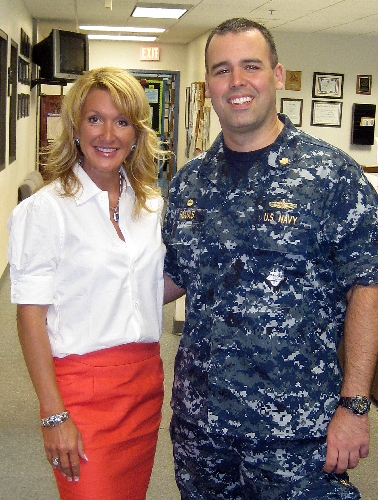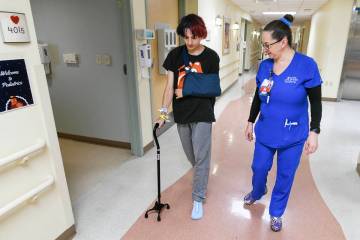Las Vegas-based research team working on new PTSD treatment
A research team at the Las Vegas Navy support center is breaking ground on a new way to treat war-stressed military personnel without relying on anxiety medication.
It's called ART, not the kind with paint brushes and easels that might help relieve stress, but another kind that mental health professional Carrie Elk calls "Accelerated Resolution Therapy."
"It's nothing new or mysterious. It's just pulling elements from existing therapies that have been around a long time, and combining them in a model that works like a laser," said Elk, assistant professor and military liaison at the University of South Florida College of Nursing.
Lt. Cmdr. Raul Rojas, who leads the support center, has taken the lead in hosting the first national study site for the university's research on using ART to treat psychological trauma in military personnel. The effort to establish a national research site has been a year in the making.
The therapy involves alternating periods of back-and-forth eye movement and talking. The conversation focuses on the traumatic scene experienced or the physiological sensations that go with it. The aim is to integrate the traumatic memories into a "normal memory" to replace the repeated nightmares of veterans and others suffering from post-traumatic stress disorder.
Eye movement tends to reduce anxiety and the body sensations associated with recalling a traumatic incident - the sights, sounds, smells of the combat experience. It also helps in replacing disturbing images with less disturbing ones.
"All the elements are put together in a really nice protocol so that it reprocesses the traumatic memories very effectively. So you're talking about a traumatic scene and focusing on the physiological response to recalling that scene. We're doing that, talking, and, using eye movement," Elk said.
Her team wrapped up sessions last week with about 10 combat veterans at the Navy Operational Support Center at Nellis Air Force Base. Like others in a sample group of 80 nonactive duty personnel in Tampa, Fla., whose therapy sessions were funded by the Department of Defense, Elk and Rojas hope the program can expand.
They would like to see the sample size grow to 500 active-duty personnel, reservists and veterans, but doing so would require funding from outside sources.
Elk said at least one entrepreneur, Chris Sullivan, co-founder of Outback Steakhouse, has committed to back the research and has launched an effort to raise some $600,000 to add 420 active-duty personnel to the study.
Promising findings from the initial civilian group in a study of ART funded by the Substance Abuse and Mental Health Services Administration were published in a June scientific journal, Behavioral Sciences. But the Department of Veterans Affairs, which shoulders most of the nation's post-traumatic stress disorder burden, can't endorse the research until there is more widespread proof.
"They're keeping a pulse on it, but it needs to be deemed an evidenced-based intervention," Elk said.
"Therapy costs for sessions with mental health specialists would be less than what it costs for conducting research sessions," she said.
"Once this is scientifically established, the treatment cost would be about the cost of what the rate is for a psychotherapy session. But, instead of 12 to 14 sessions to complete, this therapy consists of a one-to-five sessions.
Techniques for coping with war stress - prolonged exposure therapy, cognitive processing therapy, and medication - "do a good job of what they're supposed to do" but don't go far enough, Elk said.
"ART aims to reprocess the traumatic memory and eliminate the traumatic response to the memory," Elk said. "It aims to work in a different way."
According to Elk, eye movements "are really relaxing so it helps to detach the physiological response to the remembering of the scenes."
They also encourage communication between the right brain and left brain in sharing the two memories.
A growing concern for using anxiety medication to treat post-traumatic stress disorder is that when the medication is combined with others or isn't available to the patient, the consequences can turn violent.
Local examples of such cases include the following:
■ Gulf War veteran Stanley Gibson was shot and killed by Las Vegas police Dec. 12. He became disoriented while driving to his apartment complex during a gap in refilling his anxiety medication. The shooting happened after officers responded to a call about a suspicious person.
■ Former Army Reserve soldier Joseph Patrick Lamoureux, an Iraq War veteran, was on at least 14 drugs, including anxiety medication, steroids and antidepressants prescribed for combat stress and a respiratory problem when he went on a shooting spree in 2008 in Pahrump.
■ Gulf War veteran Adam Kelley shot and killed himself while sitting in his truck behind a sandwich shop in 2004. He had been relying on pharmaceutical medication to treat post-traumatic stress disorder. His mother said he was on several different types of medication to treat both his mental illness and his physical problems. The medication made him sick, she said.
The ART technique is not limited to helping those who have been traumatized by combat. Others who are indirectly connected to the combat experience, like morticians and casualty assistance officers who notify next of kin about deaths, can also benefit.
"There are a lot who never see combat who have issues with PTSD," Elk said.
Local veterans interested in taking part in the research program can call 813-974-9310 to reach a study coordinator, or send an email to Elk at celk@health.usf.edu.
Contact reporter Keith Rogers at krogers@reviewjournal.com or 702-383-0308.


















